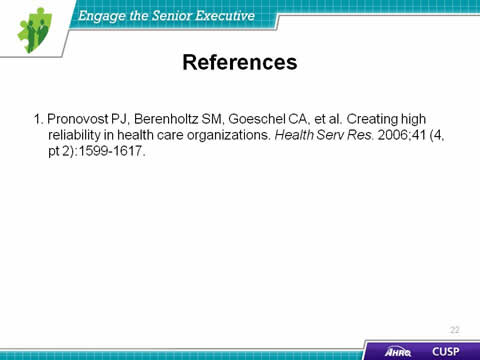Engage the Senior Executive Facilitator Notes
CUSP Toolkit
Contents
Slide 1. Introduction
Slide 2. Learning Objectives
Slide 3. Using the 4 E’s for Technical and Adaptive Work
Slide 4. Senior Executive’s Characteristics
Slide 5. The Senior Executive’s Characteristics
Slide 6. Senior Executive’s Responsibilities
Slide 7. The Senior Executive’s Roles and Responsibilities
Slide 8. Emphasizes Effective Communication
Slide 9. Meets Monthly With the CUSP Team
Slide 10. Supports Both Technical and Adaptive Work of Change
Slide 11. Supports Both Technical and Adaptive Work of Change
Slide 12. Supports Both Technical and Adaptive Work of Change
Slide 13. Collaborates To Develop and Implement a Plan Addressing Safety Issues
Slide 14. The Senior Executive’s Role on the Team
Slide 15. Holds Staff Accountable for Reducing Patient Harm
Slide 16. The Challenges of Partnering With a Senior Executive
Slide 17. How to Engage Your Senior Executive and Develop Shared Accountability for the Work
Slide 18. Exercise
Slide 19. Engage the Senior Executive: What the Team Needs to Do
Slide 20. Summary
Slide 21. CUSP Tools
Slide 22. References
Slide 1: Introduction
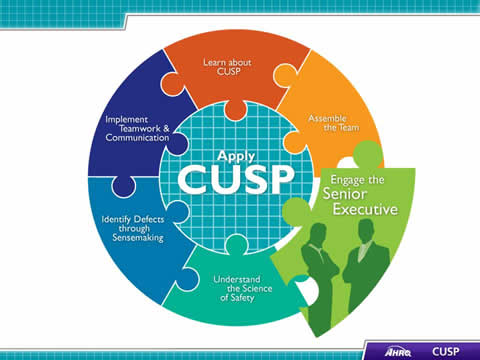
Say:
The "Engage the Senior Executive" module of the Comprehensive Unit-based Safety Program (or CUSP) Toolkit focuses on the role and responsibilities of the senior executive within the CUSP team. Engaging a senior executive to partner with a unit will bridge the gap between senior management and frontline providers and will facilitate a system-level perspective on safety challenges that exist at the unit level. The senior executive chosen should be a vice president or higher ranking official.
The senior executive’s participation and engagement in the CUSP initiative is vital to the success of the project. This module of the CUSP Toolkit provides information and several tools to use to encourage senior executives to participate in the CUSP initiative.
[D] Select for Text Description
Slide 2: Learning Objectives
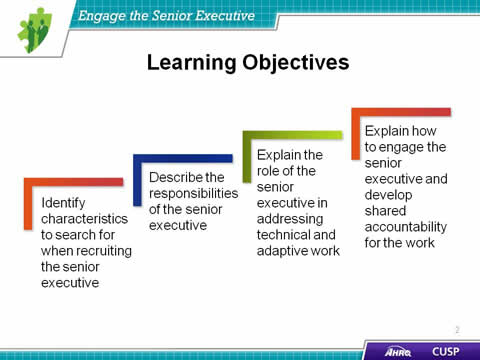
Say:
In this module we will:
- Identify characteristics to search for when recruiting the senior executive.
- Describe the responsibilities the senior executive must take on.
- Explain the role of the senior executive in addressing technical and adaptive work, and
- Describe how to engage the senior executive in the unit’s initiatives and develop shared accountability for the work needed to achieve the unit’s safety goals.
[D] Select for Text Description
Slide 3: Using the 4 E’s for Technical and Adaptive Work1
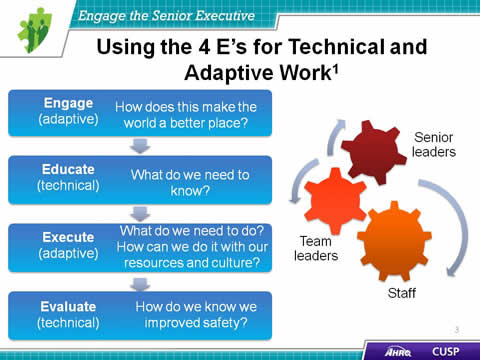
Say:
Use the 4 E’s to help when recruiting a senior executive for the CUSP team. Created by the Johns Hopkins University Quality and Safety Research Group, the 4 E’s help carry out patient safety interventions by focusing change efforts around technical and adaptive work. This model features four key elements for starting and sustaining initiatives: Engage, educate, execute, and evaluate. As part of the CUSP team, the senior executive actively employs the 4 E’s and promotes it as a model for change.
Engage
Within the 4 E’s model, engaging a staff member is an example of adaptive work in which CUSP teams help unit staff understand the effects of preventable harm caused by a clinical problem. One method of engagement is sharing stories about patients affected by this problem and estimating the number of patients who could be harmed as a result of this problem.
Educate
Education is an example of technical work in which the CUSP team transmits information to staff and senior leaders regarding actions to take to prevent clinical problems.
Execute
An example of adaptive work, execution is based on the principles of safe system design: Simplify the system, create redundancy, and learn from mistakes.
Evaluate
Evaluation is an example of technical work in which unit teams collect and submit data related to any clinical problem to analyze the progress of an intervention.
Leading units through change requires CUSP team members, including senior executives, to use technical and adaptive work to ensure the modifications made throughout the initiative remain effective as the project moves into sustainability. Because clinicians and senior executives approach patient safety initiatives in distinctive ways, communicating through engaging stories, educational evidence, proposed solutions, and evaluations need to be tailored to both audiences.
Ask:
What themes can you deduce from the 4 E’s?
[D] Select for Text Description
Slide 4: Senior Executive’s Characteristics
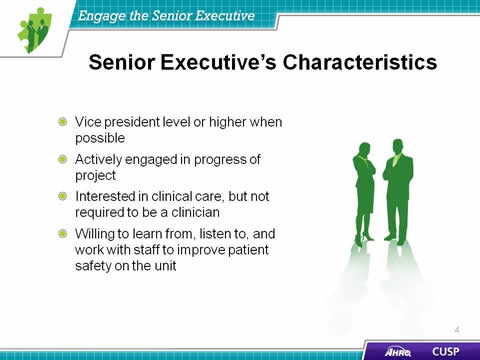
Say:
For the CUSP team and the project to function at optimal effectiveness, the senior executive should be:
- A vice president or higher ranking officer whenever possible.
- Actively engaged.
- Interested in clinical care, and
- Willing to listen, learn, and work with staff to improve patient safety and the quality of health care delivery in the unit.
Executive team members need to be in a high enough position to authorize the use of required resources to help unit-based teams resolve their patient safety issues. Senior leaders should be familiar and comfortable with the goals of the project. Executives who have a vested interest in the quality of care make great CUSP team members.
[D] Select for Text Description
Slide 5: The Senior Executive’s Characteristics
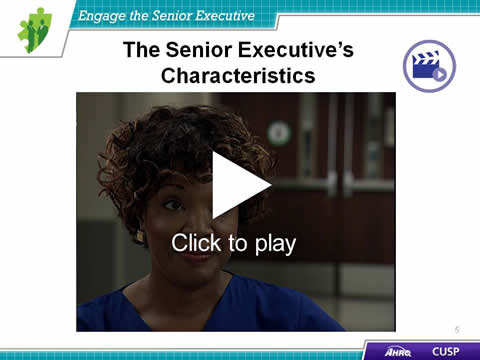
Do:
Play the video.
Ask:
What traits do the nurse manager and physician champion identify when describing the senior executive they would like to recruit for the team?
[D] Select for Text Description
Slide 6: Senior Executive’s Responsibilities
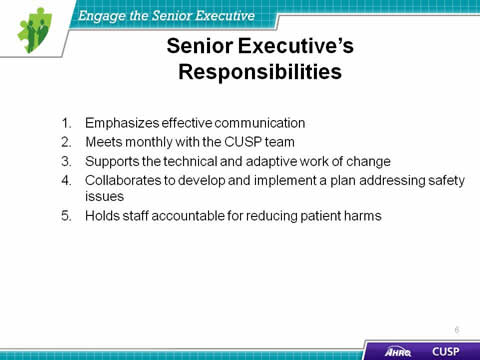
Say:
The senior executive team member will be responsible for:
- Participating in efforts to improve communication.
- Meeting with the CUSP team monthly.
- Understanding and supporting the technical and adaptive work of change.
- Collaborating with others to develop and put into effect a plan that addresses the safety issues the unit staff and other sources identify, and
- Holding all staff accountable for carrying out agreed-upon activities designed to reduce patient harms.
Ask:
Are there executives at your hospital who you believe would take on these responsibilities?
[D] Select for Text Description
Slide 7: The Senior Executive’s Roles and Responsibilities

Do:
Play the video.
Ask:
What responsibilities does the senior executive agree to accept for the project?
[D] Select for Text Description
Slide 8: Emphasizes Effective Communication
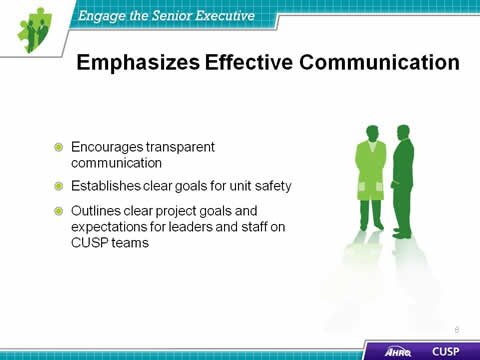
Say:
Senior executive team members are asked to encourage transparent and frequent communication and interaction among the CUSP team members. This transparency can include distributing a hospital-wide publication, announcing current infection rates on the unit, or encouraging the CUSP team members to candidly share their concerns. The frequency of these communications should align with the team’s needs.
Senior executives have the authority and means to share responsibility for establishing and reinforcing the goals of quality improvement initiatives with their unit team members. Senior executives who serve on CUSP teams can use their influence to help local units support larger hospital projects by motivating the teams and providing encouragement, perhaps publicly, of the team’s achievements. This, in turn, will help the senior executive and unit team celebrate wins and offer incentive to sustain the initiative.
Senior executives involved in an initiative at the unit level will serve as a critical link to other hospital executives. This connection between executives and frontline staff bridges communication gaps that may exist in hospital hierarchies.
[D] Select for Text Description
Slide 9: Meets Monthly With the CUSP Team
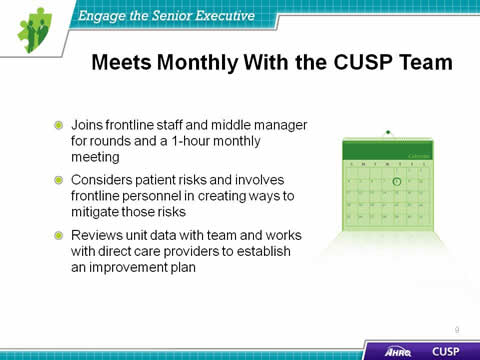
Say:
Senior executives are expected to meet and interact regularly with the other members of the CUSP team. They should also join frontline providers and managers for rounds and a monthly meeting to discuss risk management and initiative goals. These meetings are a great opportunity to share unit-level data and discuss team-wide unit improvement plans.
These interactions also provide an opportunity for the senior executive to gain a better understanding of the challenges that frontline providers face each day with implementing quality improvement projects. The candid interaction between the senior executive and unit team members is a vital component of these meetings.
[D] Select for Text Description
Slide 10: Supports Both Technical and Adaptive Work of Change
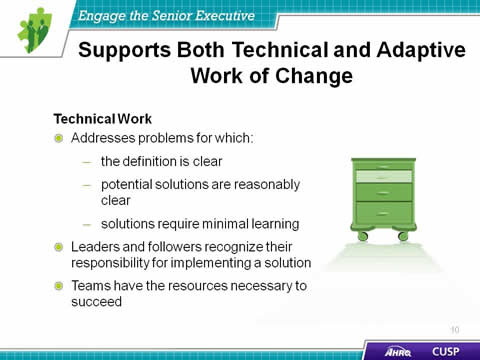
Say:
The senior executive should understand that change requires both technical and adaptive work. The technical work of change includes addressing problems for which the:
- Definition is clear, the potential solutions are relatively explicit, and solutions usually require minimal learning.
- Responsibility for implementing a solution is fairly apparent between leaders and followers; and
- Teams have the resources necessary to succeed.
Technical solutions to problems are often straightforward and easy to put in place. They may require the application of new procedures, training, or data collection methods; however, they require very little cultural or attitude change to be successful.
For example, at a small community hospital, staff identified issues with recruiting physician champions for their CUSP teams. Having already successfully recruited their senior executive partners, the unit teams needed to find unit physicians to join their CUSP teams. Because of the ties the senior executive partners had with hospital administration, the unit teams relayed their concerns to hospital administrators, who then looked into the matter. The administrators found that unit physicians were not receiving important communications about training and team-building events and also could not attend many of these events because they conflicted with their office hours.
In a solution that paired technical problem solving with accountability, the hospital established a single intranet site where hospital physicians could find updates on essential meetings and events, including those addressing quality and patient safety initiatives. The senior executives accepted responsibility for updating the site every 2 weeks. Physicians were held accountable for checking the calendar and were relieved of the worry of missing an important email or notice related to their participation in these initiatives. The intranet site allowed the senior executive team members to embody the technical work of change. Their work on this project required a modest amount of effort. The adaptive role of these hospital executives in this story is addressed on the next slide.
Another example of a technical solution comes from a common unit-based safety issue many hospitals encounter: The lack of necessary supplies for inserting and maintaining central lines. To address this, one unit team established a cart to house all the necessary supplies for a clinician to safely insert a central line for a patient in the ICU. This line cart also contained a checklist requiring unit staff to verify the items were stocked in the cart. This technical solution to their unit-based problem—the line cart and supply checklist—increased staff accountability in relation to necessary materials without requiring major changes in unit culture or education.
Examples of other common technical issues unit teams encounter daily are time allocation, staffing resources, staff training, and locating supplies to complete their jobs successfully.
Senior executives who engage in the technical work of change actively assist their unit-level teammates with solutions to common problems, such as new procedures or increasing resources.
Ask:
- Can you identify any technical solutions to existing problems on your unit?
- What made the technical solution successful?
[D] Select for Text Description
Slide 11: Supports Both Technical and Adaptive Work of Change

Say:
Similar to his or her role in addressing technical work, the senior executive must understand and support the adaptive work of change. Adaptive work addresses issues that require a shift in attitudes, beliefs, and behaviors, including sharing the responsibility for change among leaders, staff, and key stakeholders.
Adaptive work requires unit-wide cultural adjustments. Unit team members should work together to create new policies for solving unit-wide problems.
As discussed earlier, the senior executives of a small community hospital collaborated with frontline providers to create a technical solution (intranet) to engage physicians. In conjunction with creating the intranet site, the hospital sponsored a focus group on a Saturday morning to respond to the needs of the hospital physicians. This resulted in the development of safety training and events that the physicians felt would best address their concerns. The outcome was a series of physician-led quarterly gatherings attended by hospital leaders, quality improvement staff, and patient safety staff.
After putting the technical and adaptive solutions in place, the hospital saw an improvement in physician involvement in CUSP initiatives. The CUSP teams were able to endorse cultural change and engage a group of skilled participants to further the success and sustainability of the project.
Effective senior executive leaders help people successfully adapt to change by reinforcing attitudes, beliefs, and behaviors that facilitate the initiative. Possible ways to address issues that require an adaptive solution are implementing an evidence-based checklist for key procedures, creating an action policy if an evidence-based protocol is breached, and holding individuals accountable for following new policies.
Ask:
- Can you identify any adaptive solutions to problems on your hospital unit?
- What attempts to address adaptive challenges were made?
- What types of cultural change will these solutions require if implemented on your unit?
- Why do you think they may or may not be successful?
[D] Select for Text Description
Slide 12: Supports Both Technical and Adaptive Work of Change
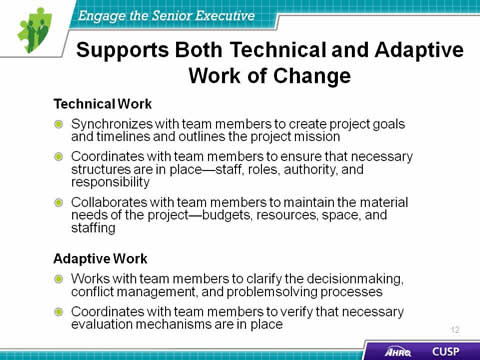
Say:
When engaging team members with technical and adaptive work, senior executives should know how to collaborate with their unit team members to support both types of work. Senior leaders should be able to work with team members to:
- Create project goals and timelines and outline the project mission.
- Confirm necessary structures are in place.
- Maintain the material needs of the project.
- Verify the decisionmaking, conflict management, and problem-solving processes are clear, and
- Ensure necessary evaluation mechanisms are in place.
By collaborating with their CUSP team members to guarantee clarity with project timelines and deadlines or, if necessary, that materials and resources are in place, senior executives are initiating the technical work of change. Senior executives conduct adaptive work when partnering with CUSP team members to establish that essential structures exist for project success, including evaluation mechanisms and decisionmaking processes.
Despite their differences in solution applicability, technical and adaptive work involve unit team members in initiatives, regardless of their position or title within the unit.
By cooperating with their CUSP team members on elements of project management, senior executives are able to build an environment in which communication among unit team members is welcome and candid.
Do:
The following questions are similar to those that senior executive team members should ask their unit teammates to encourage engagement in the CUSP initiative. In pairs or on your own, identify whether these questions address technical or adaptive problems.
- Are team members clear on the goals, timelines, and mission? (Technical)
- Are necessary structures (people, roles, authority, and responsibility) in place? (Technical)
- Are material resources (space, equipment, people, and budgets) accessible? (Technical)
- Are decisionmaking, problem-solving, and conflict management processes understandable? (Adaptive)
- Are mechanisms established to evaluate progress? (Adaptive)
[D] Select for Text Description
Slide 13: Collaborates To Develop and Implement a Plan Addressing Safety Issues
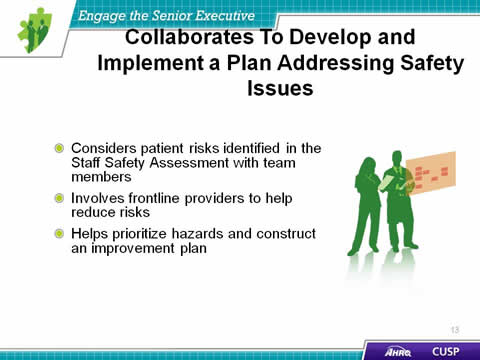
Say:
After determining technical and adaptive concerns, senior executives will be able to collaborate with their unit team members to implement solutions.
The senior executive should:
- Work with team members to consider patient risks identified in the Staff Safety Assessment, which is discussed later in this module.
- Involve frontline providers to help reduce risks.
- Help prioritize risks and develop an improvement plan, and
- Hold himself or herself and unit staff accountable for implementing the plan.
By addressing patient risks identified in the Staff Safety Assessment, senior executives are partnering with their teammates to tackle risks at the unit or hospital level. Further, when prioritizing risks and developing an improvement plan with the team, senior executives can help allocate resources as part of the solution.
[D] Select for Text Description
Slide 14: The Senior Executive’s Role on the Team
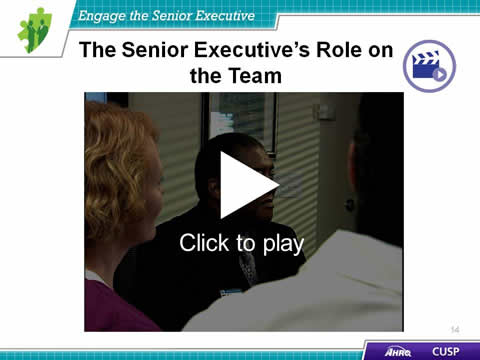
Do:
Play the video.
Ask:
According to the physician champion, how did the senior executive help implement the initiative among physicians on the unit?
[D] Select for Text Description
Slide 15: Holds Staff Accountable for Reducing Patient Harm
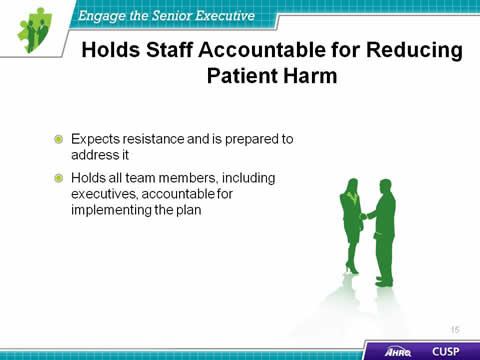
Say:
Senior executives need to be equipped with the tools and skills to hold themselves and staff members accountable for reducing patient risks because team members are responsible for holding each other accountable for reducing patient harm.
As mentioned earlier, the senior executive’s ability to allocate resources and use his or her senior leadership ties are crucial to sustainability. To help establish his or her role on the CUSP team, the senior executive should try to attend all CUSP meetings and unit walkarounds and stay knowledgeable about the current status of the project. Throughout the initiative, senior executives should know how to engage and offer incentives to their team members but should also be prepared to address issues regarding compliance and communication as they occur.
Senior executives should expect and be ready to address resistance to the changes that accompany any patient safety initiative. Senior executives must be an enthusiastic and a visible presence as a part of a CUSP team.
[D] Select for Text Description
Slide 16: The Challenges of Partnering With a Senior Executive
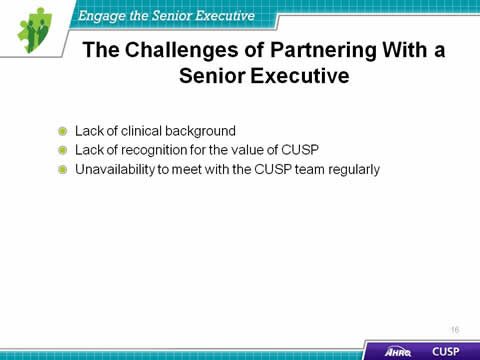
Say:
When engaging the senior executive member of the CUSP team, you may encounter the following hurdles:
- Lack of clinical background,
- Lack of recognition for the value of CUSP, and
- Unavailability to meet regularly with the CUSP team.
These hurdles are external, and many senior executives can be effectively engaged with the proper technique. By following the 4 E’s, CUSP teams will be able to customize their appeal and project approach to meet the needs and background of the senior executive, further increasing the success and sustainability of the initiative.
If senior executives cite their lack of a clinical background, CUSP team members can focus their appeal on the fiscal gains associated with patient safety initiatives. If senior executives are unable to see the value of CUSP for the unit or hospital, CUSP team members should relate success stories or real data that highlight the triumphs other unit teams have experienced when implementing CUSP initiatives at their facilities. If senior executives claim their busy schedules as a barrier to involvement in the project, the CUSP team can arrange monthly meetings via conference calls.
Ask:
What barriers do you foresee in appointing a senior executive to serve as a member on your CUSP team?
[D] Select for Text Description
Slide 17: How to Engage Your Senior Executive and Develop Shared Accountability for the Work
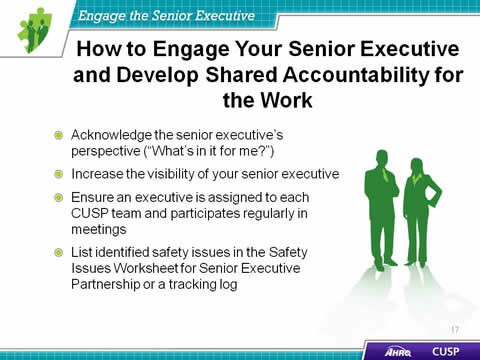
Say:
Just as it is critical to detail the responsibilities of the senior executive, it is equally important for CUSP team leaders to realize how to engage the senior executive while developing shared accountability among the team. This may be difficult to do. Executives and frontline providers serve different roles within the hospital. As a result, their interest in and the skills they contribute to the CUSP initiative will vary greatly.
Present the senior executive with the benefits of his or her participation in the project. Remember to appeal to his or her interests both in maintaining patient safety and in the financial gains that will result from participating in the CUSP initiative. Display statistics that show the positive effects of the CUSP initiative in the areas surrounding patient harm and the average cost per occurrence for the hospital.
An easy way to increase the visibility of the CUSP team’s senior executive is to post that person’s photo and name on a bulletin board. By doing so, you create a tool for all staff members to readily identify their senior executive team member. Another way is to ask the senior executive to attend a getting-to-know-you interview. To accommodate everyone’s schedule, this interview can be completed by one staff member, and the responses can be shared with the unit team.
Each CUSP team must be assigned at least one senior executive team member. This senior executive should meet with the CUSP team regularly and be included in any project-related communications. Recruiting executives in these initiatives forges bonds and improves communication among hospital staff, which will ultimately increase patient safety and reduce unnecessary expenses and harm.
List identified safety issues
One of the most effective approaches to bridge the gap between senior management and frontline providers is to conduct executive safety rounds. During these rounds, executive team members mingle with staff on the unit while discussing safety issues. The importance of these interactions taking place in the unit is twofold. First, unit-based gatherings offer the executive the opportunity to gain a greater understanding of project ownership and cultivate a sense of their integral role within the unit team. Second, meeting on the unit floor also increases senior executive visibility among frontline staff and imparts a stronger impression of commitment to the project. As a team, the executive and other team members can investigate a staff-identified safety defect listed on the Learning From Defects Tool or the Safety Issues Worksheet for the Senior Executive Partnership. This unit-wide interest in patient safety will enhance the likelihood of executive participation and engagement in the initiative and will, in turn, improve work culture.
Ask:
- How do you plan to engage the senior executive in your CUSP initiative?
- What might he or she want to know about your unit before they agree?
- What will your staff want to learn about the executive and their role before you get started?
[D] Select for Text Description
Slide 18: Exercise
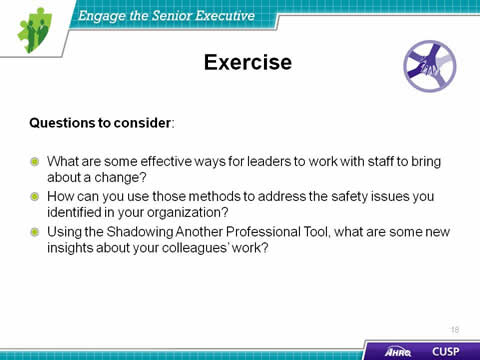
Ask:
- What are some effective ways for leaders to work with staff to facilitate change?
- How can you use those methods to address the safety issues you identified in your organization?
- What are some new insights about your colleagues’ work that you learned from using the Shadowing Another Profession Tool?
[D] Select for Text Description
Slide 19: Engage the Senior Executive: What the Team Needs to Do
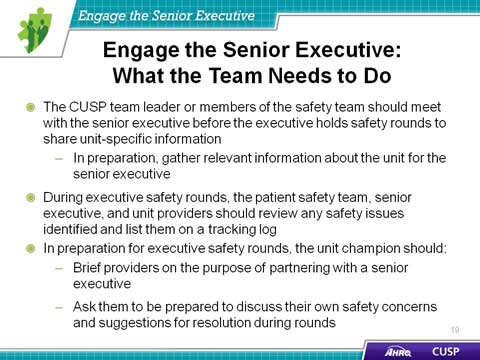
Say:
The first step in working with a senior executive partner should be to discuss information specific to the unit before he or she initiates safety rounds. In preparation for this meeting, teams should gather relevant information about the unit for the senior executive. Infection rate data, stories of recent near-misses, or instances of harm are imperative for the executive partner to know before initiating rounds. Team leads should also brief the executive partner on the configuration of the unit’s CUSP team and on any safety issues that staff members have raised formally or informally.
During these safety rounds, the patient safety team, senior executive, and unit providers should review any safety issues documented and note them on a tracking log. In preparation for executive safety rounds, the CUSP team leader should brief providers on the purpose of partnering with a senior executive and ask staff to be ready to discuss their own safety concerns and suggestions for resolution.
While unit teams and unit-level managers can easily meet to discuss potential threats to safety, without the buy-in and full engagement of executive leadership, it will be difficult to secure the resources that are often required to implement system changes. By engaging a senior executive partner, a unit can gain a crucial ally in getting the resources needed for change.
[D] Select for Text Description
Slide 20: Summary
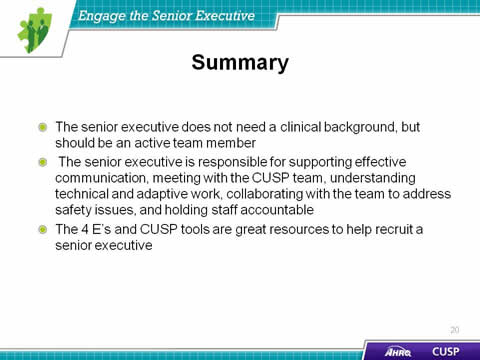
Say:
The senior executive does not need a clinical background but should be an active team member.
The senior executive is responsible for supporting effective communication, meeting with the CUSP team, understanding technical and adaptive work, collaborating with the team to address safety issues, and holding staff accountable.
The 4 E’s and CUSP tools are resources to help recruit a senior executive.
[D] Select for Text Description
Slide 21: CUSP Tools
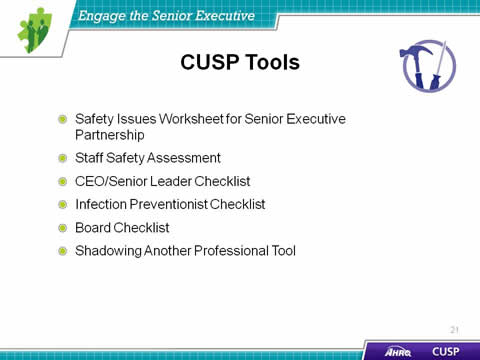
Say:
In addition to the information presented in this module, CUSP tools are available online by visiting the AHRQ Web site.
Safety Issues Worksheet for Senior Executive Partnership
The Safety Issues Worksheet for Senior Executive Partnership is a document that helps unit teams and their executive team member discuss provider-identified safety issues that require an executive intervention.
CEO/Senior Leader Checklist
The CEO/Senior Leader Checklist helps the senior executive assign project responsibilities and standardize the roles of unit team members who are participating in the CUSP initiative. This checklist accounts for all the necessary tasks the CUSP team needs to complete to ensure the success and sustainability of the CUSP initiative.
Staff Safety Assessment
The Staff Safety Assessment helps the senior executive collaborate with frontline providers to identify and understand possible risks within the unit. Frontline providers complete this assessment, highlighting areas of concern for the senior executive to address with the unit team.
Board Checklist
The Board Checklist is meant to engage members of the hospital board in the CUSP initiative. It facilitates the completion of a strategic safety plan that can be used hospital wide. Items on this checklist also help guide the board in developing the means to assess, review, and improve culture within the hospital. Additionally, checklist items help facilitate the completion of tasks on the CEO/Senior Leader Checklist.
Shadowing Another Professional Tool
The Shadowing Another Professional Tool allows unit team members to examine and understand the cultural differences that exist among various professions. Executives and clinicians approach issues very differently, and using this tool helps provide a better insight into colleague work culture and how other team members approach similar issues. This permits unit teams to engage each other in projects and tasks based on the knowledge gained from shadowing their peers and learning about diverse jobs and attitudes.
[D] Select for Text Description
Slide 22: References
- Pronovost PJ, Berenholtz SM, Goeschel CA, et al. Creating high reliability in health care organizations. Health Serv Res. 2006;41 (4, pt 2):1599-1617.
[D] Select for Text Description




